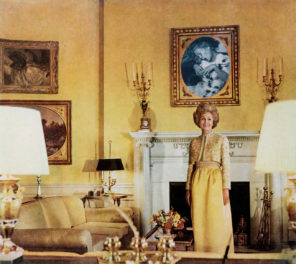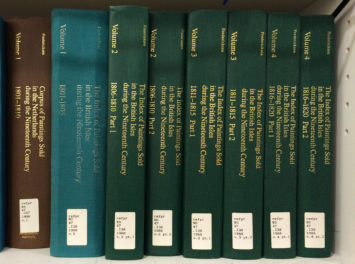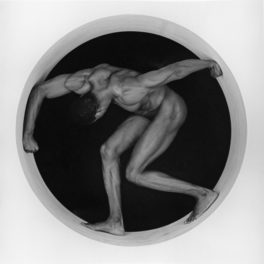There are surprising parallels between the sister cities of Berlin and Los Angeles, as is convincingly shown in the exhibition Berlin/Los Angeles: Space for Music—kinships not only in urban development, but also in the arts and philosophical outlook. A common thread persists below the surface of the obvious differences in their histories.(1)
By comparing two of the most iconic structures built for music performance over the last century, the exhibition at the Getty Research Institute illustrates some of the two cities’ commonalities in a new and revealing way. The juxtaposition of Hans Scharoun’s 1963 Philharmonic in Berlin and Frank Gehry’s 2003 Disney Hall in L.A. brings to light strong similarities from architectural, acoustical, and musical, as well as social and urban, points of view.
Spaces for Music
Both projects can be seen as the culmination of each architect’s development toward a perfect space for musical performance. Hans Scharoun had designed and built theaters before, incorporating elements that would reach their ultimate expression in the concert hall for the Berlin Philharmonic. During the long political hiatus that delayed the construction of Disney Hall by a decade, Frank Gehry had the opportunity to design the Guggenheim Museum in Bilbao. The formal language and expressive power of that project translated seamlessly to the Los Angeles concert hall.
Sketches and models by Scharoun and Gehry, as well as photographs of the two buildings, show a clear lineage between the two structures and their architects. To see a 1940s Scharoun watercolor sketch directly above a 2012 photograph of Disney Hall is a revelation. Further proof of a close connection is easy to find throughout the exhibition, in drawings and writings about the architecture, but also in the relationship of these firm yet fluid structures with their intended use as vessels dedicated to music.
Gehry’s question “If architecture is frozen music, is music liquid architecture?” and Scharoun’s statement “Music should be at the center, spatially as well as visually” sum up many of the ideas behind the two buildings.
As Scharoun continues: “Here the creation and the experience of music occur in a hall not motivated by formal aesthetics, but whose design was inspired by the very purpose it serves” (2). Although his exuberant expressionism was somewhat of an outlier within the orthodoxy of the time, Scharoun’s design, completed at the height of the modern movement, is a pure expression of the shape of the main auditorium, with even the smallest ancillary space being greatly influenced by it. There are no shortcuts; the architectural form is determined by its function, artistically, acoustically, and socially.
Disney Hall, designed fifty years later, is freer in its approach. The exterior does not literally represent the auditorium, and acoustically the hall is more of a hybrid between the revolutionary vineyard concept Scharoun perfected, with terraced seating around the orchestra at center, and the traditional shoebox shape of more traditional halls.
The exhibition traces architectural history up to the present by spotlighting another concert hall by Frank Gehry, the newly completed Pierre Boulez Hall in Berlin. Another hybrid, this project places a smaller vineyard-type auditorium inside a rectangular box, all within an existing historic building, reminiscent of Gehry’s DZ Bank building in Pariser Platz just down the street.

Interior, Pierre Boulez Hall, Berlin. Photo: Chris Edwards

The DZ Bank Building in Pariser Platz in Berlin, Germany, by Frank Gehry. Photo: Mogadir, licensed under a Creative Commons Attribution-Share Alike 3.0 license (CC BY-SA 3.0). Source: Wikimedia Commons
The inclusion of the Pierre Boulez Hall highlights the affinity between the two architectural main acts and reinforces the social agenda espoused by both Scharoun and Gehry. Serving the Barenboim-Said Academy, an institution that is meant to bring together Palestinian and Israeli musicians, the new Boulez Hall signifies much more than just a space for music.
Elite Utopianism
A democratic, humanitarian, and utopian approach was at the core of Scharoun’s work. He meant to design buildings for all people—not just the elite few. Similarly, Gehry’s interpretation of donor Lilian B. Disney’s wish for a garden resulted in a new public open space, and his insistence on allowing public access to walk up and around the hall has enriched the urban landscape around Disney Hall.
The dedication of Gehry’s newest Berlin project to Pierre Boulez, a giant of modern classical music, is fitting as well. Scharoun’s Philharmonic was meant as an experimental space, trying out new audience and stage configurations, and even orchestral arrangements, in the service of the music and its performance and experience. Likewise, Disney Hall is designed for new and contemporary music as much as for a traditional classical repertoire. Music director Esa-Pekka Salonen helped reinforce that mission, and the inclusionary approach fostered by his successor Gustavo Dudamel further expands its social relevance.
New Spaces for Music
Despite all these progressive ideals, all three projects still represent the epitome of elite culture, rarified structures in a chaotic world. The concert halls represent a visionary ideal, but in both Berlin and LA countless other spaces for music exist in many other forms—more improvised, non-traditional, and open-ended, sometimes even scrappy and run-down.
Both metropolises are creative centers of film, home to the oldest large film studio in existence, Babelsberg Studio outside Berlin, and to the large-scale entertainment production complex known as Hollywood in and around Los Angeles. Film and music being closely related, the highly accomplished musicians in both cities often work on movie scores, in closed scoring stages, studio spaces, and production facilities. Away from the public eye, music is made in a multitude of different spaces.

Musician Jody Boyd recording piano in the studio, away from the spotlight. © Ansel Olsen

Orchestra scoring a movie at the Newman Scoring stage at 20th Century Fox. © Ed Colver
Studios for recording and music production complement a vibrant live music scene in both cities. David Bowie was a legendary musical visitor to Berlin, where he recorded some of his most creative albums. He recalls a story told by his friend Iggy Pop, who had been out late at a punk club on the anniversary of the Berlin Wall’s construction. A replica of the wall had been put up in the basement club and was then viciously torn down by the patrons. After the riot, in an affecting scene, the hardened punks sat down, exhausted, with tears streaming down their faces. Music, world politics, the sadness of the divided city, the revolt of the disenfranchised, and architecture all came together in that basement space. (3)
Like the teenage addict protagonist in the movie We Children from Bahnhof Zoo (4) who looks forward to Bowie’s concert, people in all circumstances are inspired and moved by music. The sound and the spaces in which it is made offer a temporary escape from sometimes-harsh reality.
Both Berlin and LA provide endless spatial opportunities for the making and production of music. The decommissioned factories used for techno dance parties in Berlin, the rock ’n’ roll clubs along Sunset Strip, the thousands of garage and home studios in LA, the basement jazz clubs, the rap venues in South LA, the open-air festival grounds, the piers and squares and stadiums, are all part of a landscape of spaces for music that is less pristine and sophisticated, but maybe even more democratic than the shining temples of the concert hall.
While the three extraordinary projects featured in Space for Music represent the pinnacle of architecture and space for music and culture, they are just the tip of the proverbial iceberg.
Notes
1. Berlin/LA: Spaces for Music, Architecture and Film by Marissa Clifford and Emily Pugh.
2. Peter Blundell Jones, Hans Scharoun (London: Phaidon Press Ltd., 1995), pp. 35–36.
3. VH1 Storytellers, David Bowie, 1999
4. “We Children from Bahnhof Zoo” (Christiane F – Wir Kinder vom Bahnhof Zoo), 1981; directed by Uli Edel; soundtrack by David Bowie





Comments on this post are now closed.